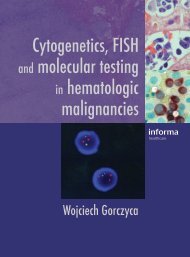Color Atlas of Hematology - Practical Microscopic and Clinical ...
Color Atlas of Hematology - Practical Microscopic and Clinical ...
Color Atlas of Hematology - Practical Microscopic and Clinical ...
- No tags were found...
Create successful ePaper yourself
Turn your PDF publications into a flip-book with our unique Google optimized e-Paper software.
96 Abnormalities <strong>of</strong> the White Cell SeriesAcute Myeloblastic Leukemia (Type M 0 through M 2 in the FAB Classification).Morphologically, the cell populations that dominate the CBC <strong>and</strong>bone marrow analyses (Fig. 31) more or less resemble myeloblasts in thecourse <strong>of</strong> normal granulopoiesis. Differences may be found to varyingdegrees in the form <strong>of</strong> coarser chromatin structure, more prominently definednucleoli, <strong>and</strong> relatively narrow cytoplasm. Compared with lymphocytes(micromyeloblasts), the analyzed cells may be up to threefold larger.In a good smear, the transformed cells can be distinguished from lymphaticcells by their usually reticular chromatin structure <strong>and</strong> its irregularorganization. Occasionally, the cytoplasm contains crystalloid azurophilicneedle-shaped primary granules (Auer bodies). Auer bodies (rods) areconglomerates <strong>of</strong> azurophilic granules. A few cells may begin to displaypromyelocytic granulation. Cytochemistry shows that from stage M 1 onward,more than 3% <strong>of</strong> the blasts are peroxidase-positive.Characteristics <strong>of</strong> Acute LeukemiasAge <strong>of</strong> onset: Any age.<strong>Clinical</strong> findings: Fatigue, fever, <strong>and</strong> signs <strong>of</strong> hemorrhage in laterstages.Lymph node <strong>and</strong> mediastinal tumors are typical only in ALL.Generalized involvement <strong>of</strong> all organs (sometimes including themeninges) is always present.CBC <strong>and</strong> laboratory: Hb , thrombocytes , leukocytes usuallystrongly elevated (~ 80%) but sometimes decreased or normal.In the differential blood analysis, blasts predominate (morphologiesvary).Beware: Extensive urate accumulation!Further diagnostics: Bone marrow, cytochemistry, immunocytochemistry,cytogenetics, <strong>and</strong> molecular genetics.Differential diagnosis: Transformed myeloproliferative syndrome(e.g., CML) or myelodysplastic syndrome.Leukemic non-Hodgkin lymphomas (incl. CLL).Aplastic anemias.Tumors in the bone marrow (carcinomas, but also rhabdomyosarcoma).Course, therapy: Usually rapid progression with infectious complications<strong>and</strong> bleeding.Immediate efficient chemotherapy in a hematology facility; bonemarrow transplant may be considered, with curative intent.






